Extreme test with boxed cooler
If we had already reached the limits of the cooler during the individual tests, we now want to test what is really possible maximum if the CPU and graphics unit are used to the maximum in parallel. Balancing is once again of interest, but also the maximum power consumption and, of course, the waste heat and its professional disposal. We would like to point out once again that this extreme scenario is a little unpractical, but both APUs have to survive anyway. Like this or like that.
AMD Ryzen 3 2200G
The 95°C, from which the APU has already exceeded the thermal limits, is estimated to be six minutes, whether the fan of the cooler is running at full speed or not. It's borderline, but it's running. Even the hottest voltage converters are already scratching at the 80°C mark. The average power consumption is now already a good 88 watts and in the peaks with just over 99 watts one is already just below the 100 watt mark.
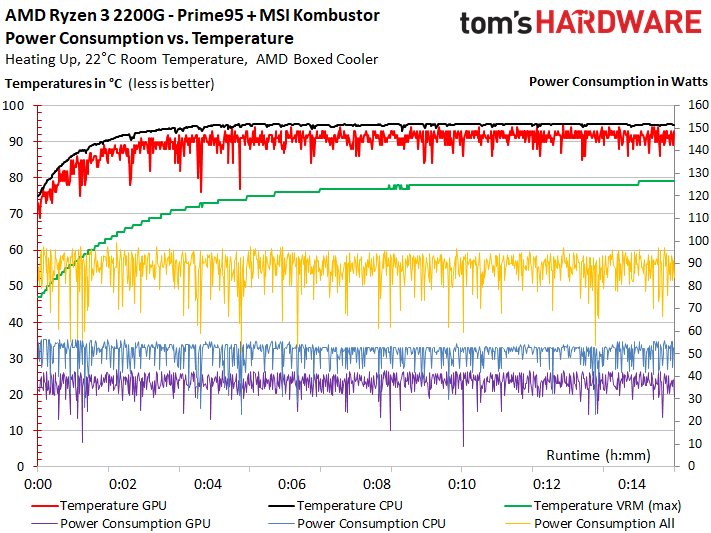
We see that when the CPU exceeds 94.5 watts, the clock starts to drop slightly, but the balance is quite neatly solved and the 100 MHZ missing at the end should be loosely plugged away. Especially since the graphics unit is not affected by this. Thus, even with the Boxed cooler, this test has been passed, albeit extremely short and with slight smears.
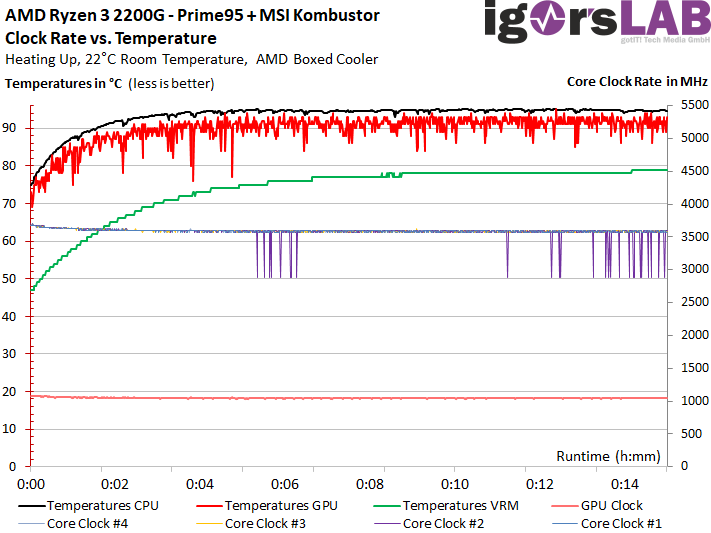
AMD Ryzen 5 2400G
We already guessed it: with the bigger sister we will run into the limit, since the mouse does not bite off a thread. The approx. 99 watts on average over the 15 minutes (especially after the throttling) and the peaks of almost 128 watts (before the throttling) are nothing that this small aluminum cooler would still get away clean. How about? After about three minutes, the magnificence of the Power is over and the CPU throttles down as scheduled. After that, you can get to about 92°C in the hottest places and the voltage converters get 80°C hot.

If you look at the corresponding clock frequencies, you can see the phase in which the throttling begins much more clearly. The control system first tries to stay in balance by hectic up and down the CPU. Only after this is of no use over a period of just under 2 minutes and the 95°C is reached, does the APU pull the emergency brake. The (light) lowering of the cpu and GPU clock speeds, together with the slightly lower voltages and currents, then provides thermal relief.

A circumstance that AMD could not (or wanted to explain) to us on demand is that the APU, while it is still hectic in the temperature limit range, is also able to reach the originally higher clock later, if the load is and allow the APU to cool briefly. But as soon as the graphics unit is also affected by the limit, only a complete restart helped here, because neither GPU nor CPU ran back into normal operation after a (even longer) cooling phase.
Extreme test with Chiller
Now we use our compressor cooler, a good water block and additionally a potent wind machine to avoid all measurable thermal hotspots. The water temperature would remain even under full load at a constant 20°C if the air-conditioned room was 22°C and the wind machine was running at full power. Of course, we have given ourselves a noise emission measurement for this pass.
AMD Ryzen 3 2200G
With this monstrous cooling club, it was easy to remove the simple thermal throttling from the first test. At approx. 90 watts (average over 15 minutes) and in the tip up to approx. 101 watts, the APU will be warm to a maximum of 57°C, the voltage converters will be heated approx. 62°C. In this case, a slightly better cooler should probably still be able to cool everything loosely with air.
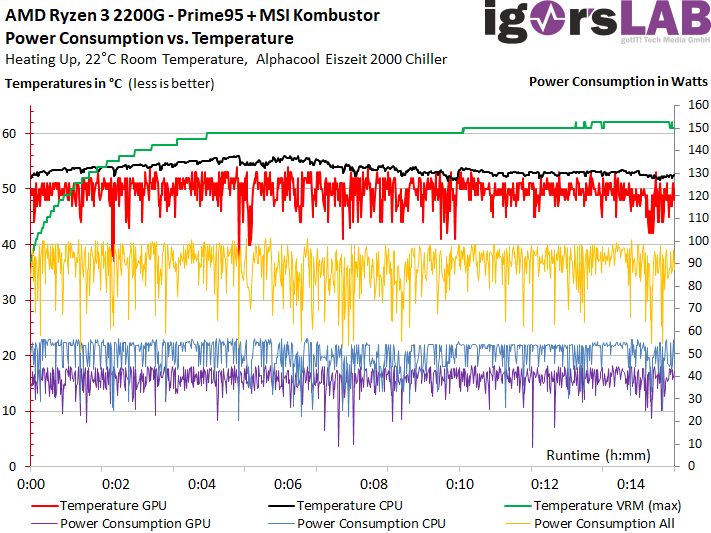
The clock frequencies of the CPU and GPU also remain stable as a one. We can see that at least the smaller APU should be elegantly manoeuvred past the Throttling, although this maximum load is already somewhat brutal. Allderings can also be regarded as a benchmark if you try to overclock properly in gaming mode.
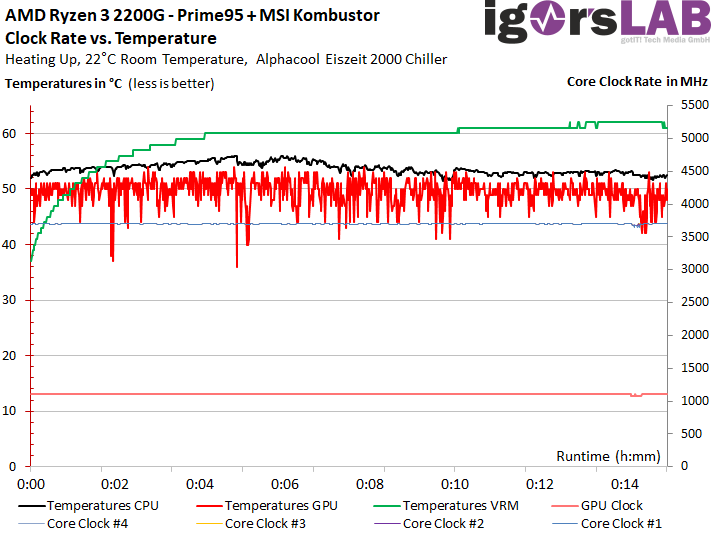
AMD Ryzen 5 2400G
With the larger APU, on the other hand, we can see quite clearly that it can't just be because of the temperatures, which is why the whole thing is so extremely throtty! The 60°C of the CPU or GPU is actually nothing, which is why telemetry would have to intervene here at all! Nevertheless, the average power consumption drops from just over 114 watts (with peak values of up to 131 watts) to approx. 100 watts, for whatever reason. The voltage converters were only approx. 64°C warm.
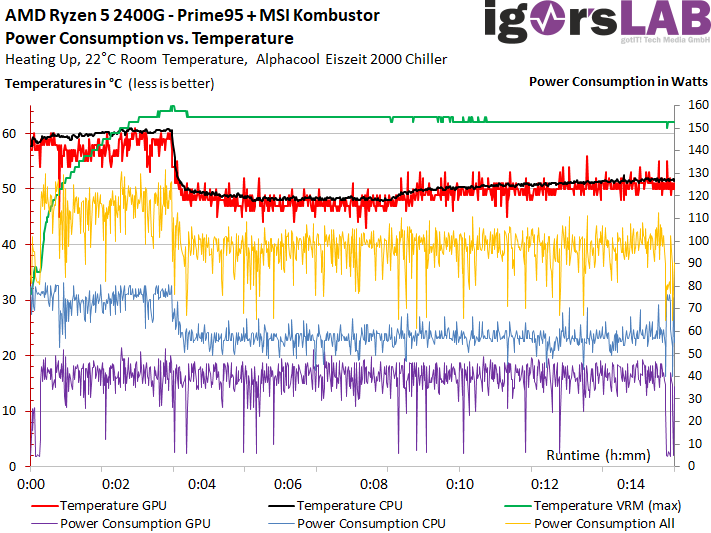
The clock frequencies also show the slump, but not as extreme as the temperatures. The GPU loses approx. 100 MHz, the CPU too. Incidentally, the full clock potential is only available again after a complete restart. Just chilling and snointing for so long didn't help.
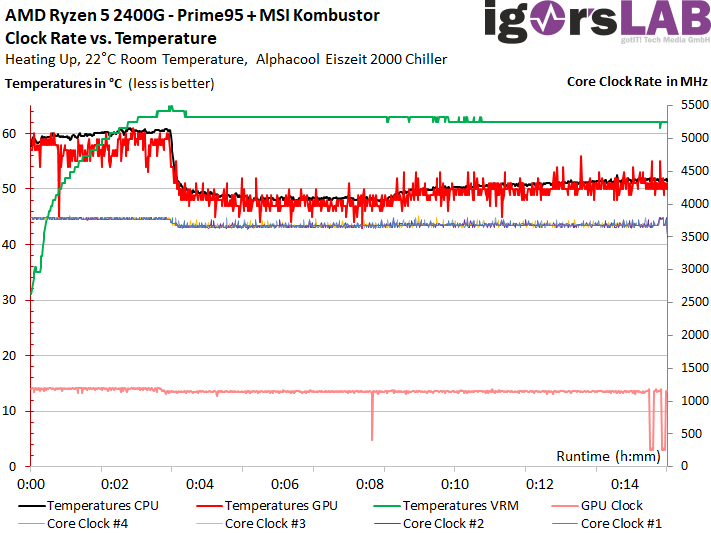

































Kommentieren